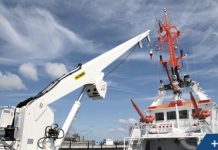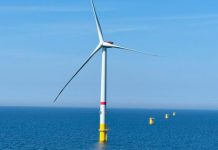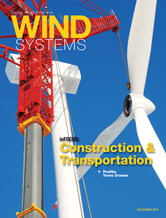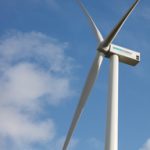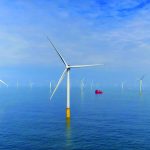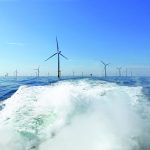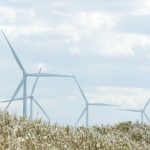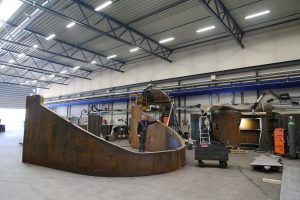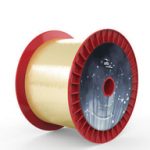Five Key Tech Trends to Watch
Preparing for the next energy storage revolution: Energy storage is one of the important elements of the pitch system. In the past, all electrical pitch systems used batteries. However, over the last few years, the cost of ultra-capacitors has come down, in large part, due to their broad adoption by the automotive industry. Ultra-capacitors, which have the major advantage of much longer maintenance intervals, have progressively taken on traditional batteries. They are likely to entirely replace batteries within the next few years as they continue to be increasingly cost-competitive.
But even as ultra-capacitors are seemingly here to stay, energy-storage technology is in such high-speed development that there is no telling what the next innovation will bring. Since energy storage systems are components that wear out relatively quickly, they might need to be replaced during the lifetime of the turbine by newer, more competitive products. For that reason, choosing a pitch system that has the flexibility to open up to different technologies for energy storage will offer a long-term advantage.
Why electrical pitch systems will finally take over hydraulic solutions: Over the last few years, electrical pitch systems have become affordable, reliable, and safe. For these three reasons they are gradually replacing the traditional hydraulic systems at an increasing rate.
Although hydraulic systems are extremely reliable and have fast pitching performances, their tendency to leak remains a significant downside, if not a deal breaker. Indeed, oil leaks are bound to occur during the lifetime of the turbine and cause significant disorder in the hub. Anybody who is familiar with operating wind farms knows that nothing is more common than the sight of black patches of oil and grease leaking down through the space between the tower and the nacelle. The fear of leaks also explains why hybrid electric-hydraulic concepts have been almost entirely abandoned.
A vast majority of the newer turbine designs rely on electrical pitch systems. Specifically, all machines designed for extreme weather conditions or for offshore — two major areas of future wind power deployment — are better suited to electrical systems that can handle hot or cold temperatures and have lower maintenance requirements.
Individual pitch control: A genuine technology breakthrough: In the wind industry, the pressure to lower the cost of energy is high. Investors who focus exclusively on lowering CAPEX and increasing the payback rate too often choose to ignore the fact that turbines deliver their energy over 25 years. However, taking into consideration the total lifecycle of the assets in order to reduce the cost of energy is paramount if the overall loads are to be lowered on the turbine as well as securing the optimal output. During the last couple of years, a number of improvements have been introduced that help run the pitch systems more effectively, the most important being Individual Pitch Control (IPC). By reducing loads, this ground-breaking technology brings the full breadth of its benefits over the entire lifetime of the wind project.
Let’s keep in mind that the pitch and turbine-control systems together represent only 4 to 6 percent of the total turbine cost depending on the turbine size. This cost can be largely offset thanks to the benefits of IPC. Not only does IPC lead to more annual production, but this innovation can also, through the reduction of structural loads, extend the lifetime of the assets by up to five years. In addition, the reduction of loads allows for a lighter overall turbine design with a cheaper bed frame, or smaller tower. IPC can enable OEMs to increase blade length while keeping structural loads low. That is a key driver to help bring turbines to lower wind areas, which is another key trend in wind-farm development.
The leading international OEMs understand the advantages of IPC well, especially those that are experienced in delivering long-term O&M contracts. Unfortunately, this approach to long-term asset management is not widespread in the industry yet. Although everybody agrees on the benefits of IPC on a theoretical level, only a limited number of OEMs already have implemented it in their designs. One of the reasons for the relatively slow adoption of IPC is the initial installation cost of the additional hardware and software needed as well as its higher control complexity. The second reason is the lack of empirical proof of the long-term indirect financial gains. The last reason is that most pitch systems in the market today are not fast enough to use IPC. Pitch speed is key to taking full advantage of the load reduction capabilities offered by individual pitch control.
Despite all this, IPC is bound to continue to be steadily integrated into modern turbine designs, especially for offshore turbine.
Pitch system redundancy will boost offshore availability: The continuous growth in turbine size, especially offshore, poses new challenges and opportunities for pitch control. As blades are getting longer, they are exposed to increasingly asymmetric wind forces across the sweep area, creating fierce demands on the pitch system. Downtime, which causes heavy financial loses, must be avoided at all cost. Due to the reduced accessibility of assets at sea, minimizing maintenance requirements as well as increasing availability have become decisive criteria for the project owner. For the same reason, the demand for remote troubleshooting is much higher than for onshore projects. And the key to achieving all this is redundancy.
Redundancy has been the vision for a while, but excessive cost was the main impeding issue. Fortunately, offshore turbines offer significant economies of scale that should allow for the use of costlier, high-performance pitch systems, whilst still achieving the best overall cost of energy. These systems are set to deliver outstanding reliability through redundancy.
Essentially, the traditional single pitch motor design will give way to designs incorporating multiple smaller pitch motors. These motors will distribute the loads around the pitch bearing while reducing slack. Full redundancy will ensure continued availability even if one part of the system fails.
Pitch motors are heavy components, and repairs due to breakdowns are costly. However, if two pitch motors are in working condition, the turbine can still deliver energy, albeit at a reduced load, until the weather permits the maintenance crew to reach the site.
As the offshore wind industry develops, pitch control redundancy will play a key role in keeping large turbines safe and running.
Making sense of pitch systems retrofitting: Although only one-third of installed turbines globally are equipped with active pitch control systems, retrofitting them is less straight-forward than it seems. Turbines are often too small to justify the investment. In addition, old models often cannot be fitted with new pitch systems without upgrading the entire turbine control.
This situation is going to change progressively in the next five to 10 years as bigger turbine models become eligible for retrofitting. However, only 1.5- to 2-MW turbines associated with a good Power Purchase Agreement can justify the replacement with a bigger rotor, along with an upgraded pitch system. The other exception concerns poorly performing wind farms, where defective pitch systems need to be upgraded even if the rest of the turbine operates as planned.
Making the Right Blade-Pitch System Call
Reliability always comes first: Any company looking to integrate a pitch system into its turbine design must, first and foremost, recognize the pitch system is a central part of the turbine safety system. It has to work seven days a week, day in, day out. That’s why OEMs always should select partners backed by a strong track record in system reliability.
Of course, cost is an important factor, as well as reducing structural loads and extending the turbine lifetime. Nonetheless, unwavering reliability is the first consideration to take into account, because a failing pitch system can destroy the asset it was meant to protect.
One important element is the speed at which the system can pitch blades according to variations in weather conditions. This is vital when coping with extreme weather events that will eventually hit a fleet during its 25-year lifetime. When exposed to such events, lower quality blade pitch systems may not be able to cut out of the wind fast enough or as calculated, and damage the entire turbine.
The guarantee for reliability comes from the extensive field experience brought by thousands of pitch systems designed for different turbines, operating in different climates, and different countries. Only a handful of companies in the global wind industry have acquired such track records.
360-degree understanding of wind-turbine control: Secondly, pitch systems are an integrated part of the overall turbine control system, which means that the continued cohesion of its various components must be ensured. Experience has shown pitch failures often come from a lack of understanding of how intimately all the turbine control elements interact with one another.
To get the right pitch system for a turbine prototype, a complete set of simulations is required. This can be achieved by using “Bladed Models” with a full WTG model simulation. Combined with practice, know-how, and a lot of field experience, thorough simulations can determine the optimal solution.
It will also help to ensure the turbine is suited to its operating conditions. In this instance, an extensive and diversified track record and the breadth of feedback data it generates are important.
And yet, to build their turbine, some OEMs quaintly still imagine they can save costs by shopping around for the cheapest off-the-shelf components. Lowering the turbine, CAPEX becomes the only objective worth pursuing for them. Nonetheless, they are likely to learn that, for all the money it might save upfront, they will remain at the mercy of potential downtime. When failure does occur, the odds are the unfortunate OEMs will be looking for a recognized control expert within days.
Off-the-shelf products can do what they can do. At the very least, the entire control system must be thoroughly tested and assembly must be optimal. Even then, they are never going to be as well-integrated as when both pitch and turbine-control systems come from the same supplier.
The final advantage resulting from having a single technology partner for the combined control and pitch system is effective troubleshooting. All lines of inquiries are addressed in a single point of contact. It is especially useful since, in most cases, OEMs do not know which element of the system is actually causing the failure. Finally, it will help resolve issues quickly, as well as maintain a well-optimized complete system.
The benefits of system flexibility: Successful pitch-control suppliers are, above all, technology companies that have demonstrated their ability to stay at the peak of innovation over time. The level of flexibility of the selected technology is a key parameter to take into account.
With regard to turbine development, OEMs must take a long-term view of pitch control and look for a technology partner that can supply the system they need today, but also the system that will be needed in the future. Indeed, all the lessons learned from the first design can be drawn upon to create the next, more advanced system, instead of starting from scratch with every turbine prototype.
A flexible system can adapt more easily as the turbine design gets upgraded. Being flexible means staying clear of systems that have a low degree of versatility and adaptability, such as compact low voltage pitch systems. Going with mainstream technology offers high sub-components availability over time, and will ensure the best long-term benefits out of the pitch-control system.
Successful Project, Successful Partnership
Achieving optimal pitch control and minimizing structural loads requires a unique set of design and technology skills. It requires expertise in load simulation, control algorithms and wind-turbine optimization. It demands a partner that can deliver a complete design process and run all simulations of the turbine to truly deliver the optimum pitch system needed for prospective field conditions. And above all, it demands a partner that can deliver the twin goals of optimal annual production and asset safety.

















